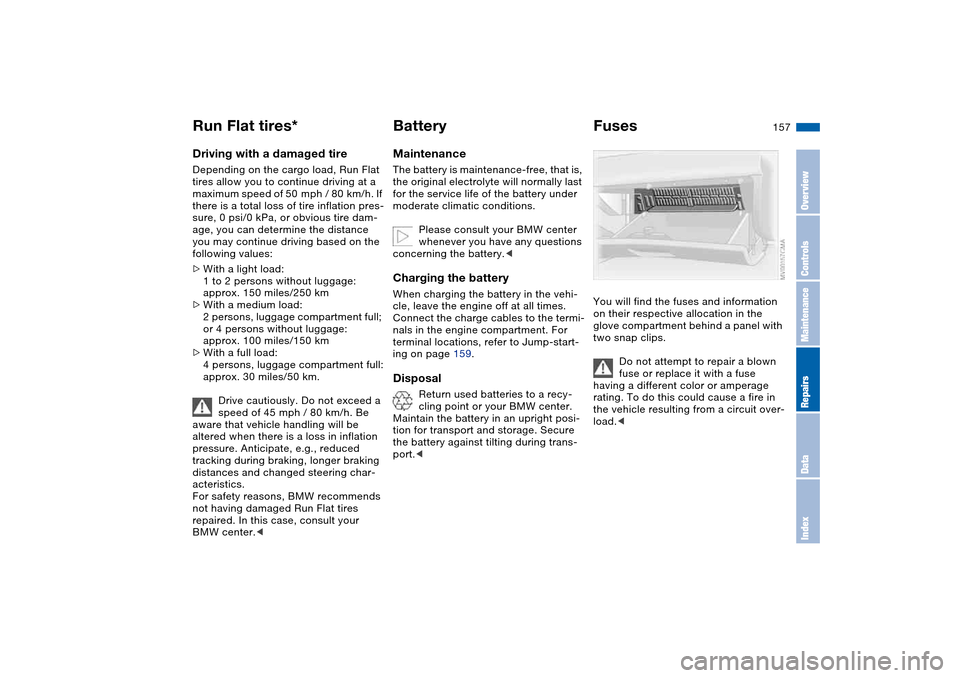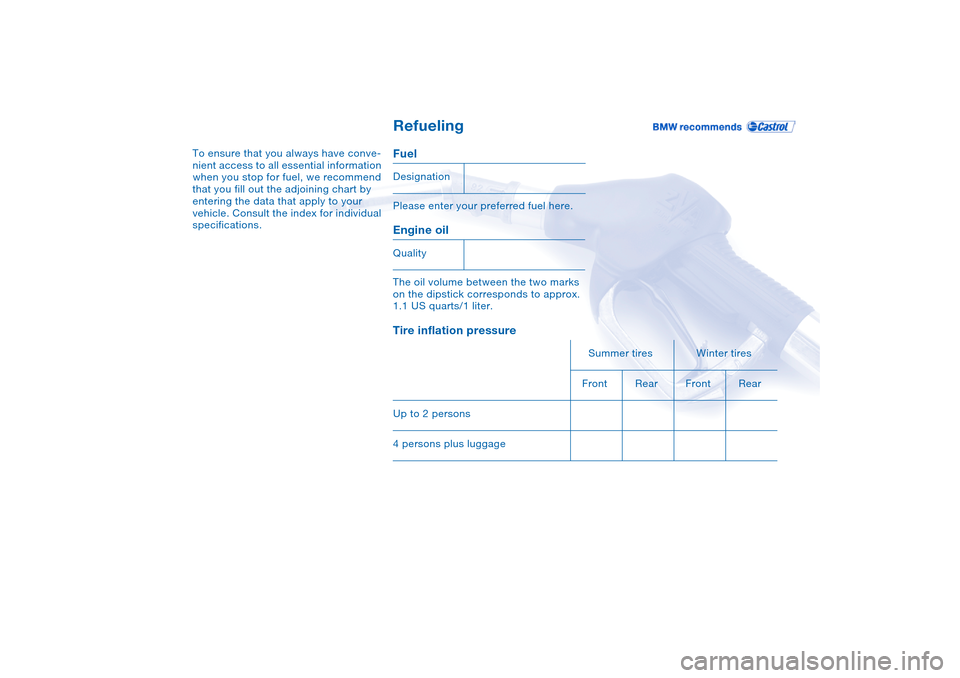2004 BMW 330CI CONVERTIBLE inflation pressure
[x] Cancel search: inflation pressurePage 133 of 186

133
the tire sidewall, refer to Changing a
wheel. In this case, use only Run Flat
winter tires, since no spare tire is pro-
vided in the event of a flat tire.Tire condition, tire pressureAt tread depths below approx. 3/16 in /
4 mm, winter tires display a perceptible
decrease in their ability to cope with
winter driving conditions, and should be
replaced in the interest of safety.
Comply with the specified tire inflation
pressures — and be sure to have the
wheel and tire assembly balanced
every time you change a tire or wheel.Snow chains*Only certain snow chains have been
tested by BMW and determined and
approved as roadworthy. Consult any
BMW center for details. BMW recom-
mends using only these approved fine-
link snow chains. Use them in pairs on
either summer or winter tires, but only
on both rear wheels.
Comply with all manufacturer's safety
precautions when mounting the chains.
Do not exceed a speed of 30 mph /
50 km/h when using snow chains.You cannot mount snow chains with the
following tires:
225/50 R 16
225/45 R 17
225/40 R 18
245/40 R 17
255/35 R 18
Do not initialize the Flat Tire Moni-
tor after mounting snow chains to
the tires.
When driving with snow chains, it may
be useful to turn off the DSC for a short
time, refer to page 94.
Page 155 of 186

155
5. Position the jack at the jacking
point closest to the flat tire with the
jack base vertically below the jack-
ing point. The entire surface of the
head of the jack moves into the
square recess of the jacking point –
refer to the detail in the next illus-
tration – when the jack is cranked
6. Continue raising the vehicle up
until the wheel you are changing is
raised from the ground
7. Unscrew the lug bolts and remove
the wheel
8. Remove accumulations of mud and
dirt from the mounting surfaces of
the wheel and hub. Clean the lug
bolts
9. Position the new wheel or the
space-saver spare tire on the hub
and screw at least two lug bolts fin-
ger-tight into opposite bolt holes
10. Screw in the remaining lug bolts.
Screw in all the bolts in a diagonal
pattern
11. Lower the jack and remove it from
beneath the vehicle
12. Tighten the lug bolts securely in a
diagonal pattern
13. Wheels with full wheel covers*:
place the wheel cover with the
valve opening over the valve. Use
both hands to press the cover
securely onto the rim
14. Check and correct the tire inflation
pressure at the earliest opportunity.
Vehicles with Flat Tire Monitor:
After mounting the spare tire or
correcting the tire inflation pres-
sure, reinitialize the system, refer to
page 95.
Protect valve stems and valves from dirt
using screw-on valve stem caps. Dirty
valve stems frequently lead to slow
pressure loss.
Do not place the full wheel cover
on the space-saver spare tire,
since this could damage the cover.<
Changing a wheel
OverviewControlsMaintenanceRepairsDataIndex
Page 157 of 186

157
Driving with a damaged tireDepending on the cargo load, Run Flat
tires allow you to continue driving at a
maximum speed of 50 mph / 80 km/h. If
there is a total loss of tire inflation pres-
sure, 0 psi/0 kPa, or obvious tire dam-
age, you can determine the distance
you may continue driving based on the
following values:
>With a light load:
1 to 2 persons without luggage:
approx. 150 miles/250 km
>With a medium load:
2 persons, luggage compartment full;
or 4 persons without luggage:
approx. 100 miles/150 km
>With a full load:
4 persons, luggage compartment full:
approx. 30 miles/50 km.
Drive cautiously. Do not exceed a
speed of 45 mph / 80 km/h. Be
aware that vehicle handling will be
altered when there is a loss in inflation
pressure. Anticipate, e.g., reduced
tracking during braking, longer braking
distances and changed steering char-
acteristics.
For safety reasons, BMW recommends
not having damaged Run Flat tires
repaired. In this case, consult your
BMW center.<
BatteryMaintenanceThe battery is maintenance-free, that is,
the original electrolyte will normally last
for the service life of the battery under
moderate climatic conditions.
Please consult your BMW center
whenever you have any questions
concerning the battery.
Connect the charge cables to the termi-
nals in the engine compartment. For
terminal locations, refer to Jump-start-
ing on page 159.Disposal
Return used batteries to a recy-
cling point or your BMW center.
Maintain the battery in an upright posi-
tion for transport and storage. Secure
the battery against tilting during trans-
port.<
FusesYou will find the fuses and information
on their respective allocation in the
glove compartment behind a panel with
two snap clips.
Do not attempt to repair a blown
fuse or replace it with a fuse
having a different color or amperage
rating. To do this could cause a fire in
the vehicle resulting from a circuit over-
load.<
Run Flat tires*
OverviewControlsMaintenanceRepairsDataIndex
Page 172 of 186

Everything from A to ZA
ABS Antilock Brake
System 125
indicator lamp 19
Acceleration assistant 78
Accessories, refer to For
your own safety 5
Accident, refer to Emer-
gency call 158
Activated-charcoal filter 110
Adaptive headlights 98
Adding brake fluid 141
Additional sources of infor-
mation 4
Air conditioning 102
Air conditioning mode 104
automatic climate
control 108
Air distribution
air conditioning 104
automatic climate
control 108
Air distribution,
individual 108
Air outlets, refer to Ventila-
tion 102, 106
Air pressure, refer to Tire
inflation pressure 25, 129
Air recirculation, refer to
Recirculated-air mode
104, 109Air supply
air conditioning 104
automatic climate
control 108
Air, drying, refer to Air con-
ditioning mode 104, 108
Airbags 61
deactivating 64
indicator lamp 18, 63
sitting safely 52
Airing out, refer to Ventila-
tion 102, 106
AKI, refer to Fuel specifica-
tions 25
Alarm system 38
avoiding unintentional
alarms 39
All-season tires, refer to
Winter tires 132
Antifreeze 140
coolant 140
washer fluid 138
Antilock Brake System
(ABS) 125
indicator lamp 19
Anti-theft system 30
Anti-theft warning system,
refer to Alarm system 38
Approved axle loads, refer
to Weights 168
Approved gross weight,
refer to Weights 168Armrest 114
Artificial leather, refer to the
Caring for your vehicle
brochure
Ashtray
front 115
rear 116
Assistant systems, refer to
Dynamic Stability Control
(DSC) 93
AUC Automatic recircu-
lated-air control 109
AUTO program, refer to
Automatic air
distribution 108
Automatic
air distribution 108
air supply 108
cruise control 84
headlamp control 97
Automatic car wash, refer to
the Caring for your vehicle
brochure
Automatic climate
control 106
Automatic curb monitor 58
Automatic dimming, interior
rearview mirror 60
Automatic recirculated-air
control (AUC) 109Automatic transmission with
Steptronic 79
indicator lamp 19, 81
interlock 71
selector lever lock 79
shiftlock 79
Automatic windshield
washer, refer to Rain sen-
sor 83
Average fuel
consumption 91
Average speed 91
Avoiding unintentional
alarms 39
Axle loads, refer to
Weights 168
B
Backrest
unlock 55
Backrest, refer to Seat
adjustment 53
Backup lamps 74
bulb replacement 151
Bandages, refer to First-aid
kit 23
Bar, towing 161
Page 177 of 186

Everything from A to Z
177
I
Ice warning 90
Ignition 71
Ignition key 30
positions 71
Ignition lock 71
Imprint 4
Indicator lamps 18
Indicator/warning lamp
airbags 18
alarm system 39
brakes 18, 19
Check Gas Cap 19
coolant 19, 87
DSC 19
Fasten safety belts 18
Flat Tire Monitor
18, 19, 95
fog lamps 20
reserve 87
rollover protection
system 19
Service Engine Soon 19
Individual air distribution 108
Individual settings, refer to
Vehicle Memory, Key
Memory 70
Inflation pressure monitor-
ing, refer to Flat Tire Moni-
tor 94
Inflation pressure, tires
25, 129INSPECTION 88
Instrument cluster 16
Instrument lighting 98
Instrument panel 14
Integrated universal remote
control 112
Interface socket for onboard
diagnostics (OBD) 143
Interior lamps 100
remote control 32
Interior motion sensor 38
switching off 32, 39
Interior rearview mirror 60
automatic dimming
feature 60
Interior temperature, adjust-
ment 104, 108
Interlock, refer to Steering
wheel lock 71
Intermittent
mode, wipers 83
Interval
display, service 88
J
Jack 153
Jacking points 154
Jump-starting 159
K
Key Memory 70Keys 30
with remote control 30
Kickdown 76, 80
L
Lamp defect 149
Lamps and bulbs 149
Lashing down loads, refer to
Cargo loading 118
Lashing eyelets, refer to
Securing cargo 120
Lashing fittings, refer to
Securing cargo 120
LATCH child-restraint
mounting system 66
Leather care, refer to the
Caring for your vehicle
brochure
LEDs light-emitting
diodes 100
Length, refer to
Dimensions 167
License plate lamp
bulb replacement 153
Light switch 97
Light-emitting diodes
(LEDs) 100
Lighter 115
LIGHTS ON warning 97
Lights, refer to Parking
lamps/Low beams 97Load, refer to Cargo
loading 118
Loading
vehicle 118
Load-securing devices 120
Lock buttons on doors, refer
to Locking 34
Lock, steering wheel 71
Locking
from inside 34
from outside 31, 33
Locking and unlocking
doors
from inside 34
from outside 31, 33
Low beams 97
automatic 97
bulb replacement 149
indicator lamp, defective
lamp 88
Lug bolts
key 154
torque 154
OverviewControlsMaintenanceRepairsDataIndex
Page 181 of 186

Everything from A to Z
181
Stroke, refer to Engine
data 166
Surface ice, refer to Ice
warning 90
Switches, refer to
Cockpit 14
Switching off
engine 73
vehicle 73
Symbols 4
Synthetic oils 139
T
Tachometer 86
Tail lamps
bulb replacement 151
Tail lamps, refer to Rear
lamps 151
Tank capacity, refer to Fuel
tank capacity 169
Tank indicator, refer to Fuel
gauge 87
Technical data 166
Technical modifications 5
Technical modifications,
refer to For your own
safety 5
Telephone hookup 115
Telephone, refer to the sep-
arate Owner's ManualTelevision, refer to the
Owner's Manual for
Onboard Computer
Temperature
air conditioning 104
automatic climate
control 108
Temperature adjustment
104, 108
Temperature display
engine coolant 87
ice warning 90
outside temperature 90
setting units 90
Temperature layering
105, 109
Tempomat, refer to Cruise
control 84
Thigh support area, adjust-
ing 53
Third brake lamp, refer to
Center high-mount brake
lamp 152
Three-point safety belt 56
Tilt alarm sensor 32
remote control 32
switching off 32, 39
Tilting passenger-side exte-
rior mirror 58
Time 89Tire pressure monitoring,
refer to Flat Tire
Monitor 94
Tire replacement 130, 153
Tires
age 131
breaking in 124
changing 153
damage 129
flat 153
inflation pressure 25, 129
replacing 130
size, refer to Wheel and
tire combinations 132
storing 132
tread 129
tread wear indicator,
refer to Tire tread – tire
damage 129
winter tires 132
Tools, refer to Onboard tool
kit 148
Torque
engine 166
lug bolts 154
Tow sockets for towing eye-
let 161
Towing bar 161
Towing eyelet 161
Towing rope 161
Towing the vehicle 161Track width, refer to Dimen-
sions 167
Transmission
automatic transmission
with Steptronic 79
sequential manual gear-
box SMG 75
Transmission lock, refer to P
Park 79
Transmission malfunction
automatic transmission
with Steptronic 81
sequential manual gear-
box SMG 77
Transport securing devices,
refer to Securing
cargo 120
Transporting children
safely 64
Trap protection
electric power windows 41
Tread depth, refer to Tire
tread 129
Tread depth, tires 129
Tread wear indicator in the
tires, refer to Tire tread –
tire damage 129
Trip distance recorder, refer
to Trip odometer 86
Trip meter, refer to Trip
odometer 86
Trip odometer 86
OverviewControlsMaintenanceRepairsDataIndex
Page 185 of 186

Refueling
To ensure that you always have conve-
nient access to all essential information
when you stop for fuel, we recommend
that you fill out the adjoining chart by
entering the data that apply to your
vehicle. Consult the index for individual
specifications.
FuelPlease enter your preferred fuel here.Engine oilThe oil volume between the two marks
on the dipstick corresponds to approx.
1.1 US quarts/1 liter.Tire inflation pressureDesignation
Quality
Summer tires Winter tires
Front Rear Front Rear
Up to 2 persons
4 persons plus luggage